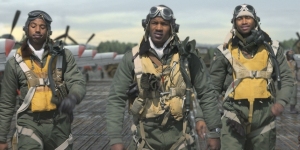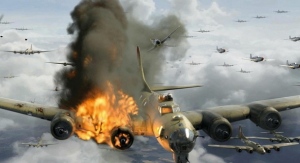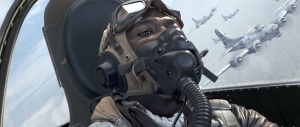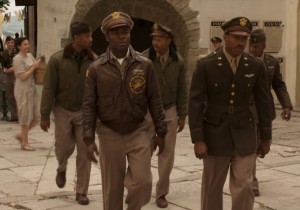Originally Posted January 21st 2012
There’s a scene early in Red Tails where two American fighter pilots are tracking a sputtering enemy plane back to a Nazi airfield. With the element of surprise on their side, the men of the 332nd fighter group start raining hellfire down on the German men and equipment. Every combustible element within a square mile blossoms into flames, and the Americans head home with a decisive victory. One of the Nazis looks on in disgust as the planes make for the horizon, the burning copses of his comrades all around him. “My god,” he says, “Those pilots were African!”

It’s that hawk-eyed attention to skin colour that’s supposed to make Red Tails stand out. It dramatizes the story of the Tuskegee airmen, the first African American pilots to see active combat in World War II, and the inequality that would confront them daily. The institutional racism that was embedded in the war effort under the Jim Crow laws presented a challenge for these men; how do you establish your worth as an equal when the orders you receive are based on low expectations? The intricacies of that conflict are all but ignored by Red Tails, which uses the story of the Tuskegee airmen as paper thin table dressing for an over-stuffed and all too familiar WWII movie.
Things get off to a bumpy start thanks to an opening combat scenario that doubles as a showcase for some grossly distracting credits. Motives and characters aren’t clear beyond the historical context of Americans good, Nazis bad, so it’s mostly just an introduction to the film’s emphasis on the aerial combat. There’s no centre holding the film together early, and once we meet the pilots, listlessly bored from routine flybys in Italy, the volume of characters introduced is overwhelming in number, but not depth.

Each man is your stock WWII character type, referred to mostly by codename, and given a particular affect for distinguishing purposes. Marty “Easy” Julian (Nate Parker) leads the squad, named for an attitude that’s the result of drinking on the job. The minute he grabs his flasks for the first time, you can see his character arc printed on it. Then there’s Joe “Lightning” Little (David Oyelowo), the cocksure aerial ace of daring-do who can’t seem to follow orders, unless they’re given by his Italian-born sweetheart. The film thinks their romance is too cute to make you question how vapid a relationship must be if the two people in it can’t verbally communicate. It isn’t.
The rest of the cast can be boiled down to their archetypes, such as the put-upon mechanic, the eager young guy, the priest, etc. You can see the path each character will go down because the territory has been so well covered by a litany of other WWII films of the same vein, only now the colour of the men’s skin shoehorns racial conflict in place of character building. Terrence Howard playing the group’s Colonel gets many of the more interesting scenes because his character has to confront racism at a bureaucratic level, not just in random encounters with bigoted American soldiers (which it turns out, is most of them). It’s perhaps structurally consistent, if not enjoyable, that when the film tries to portray the ramifications of a segregated military, it’s often as cliché as the rest of the story.

Air combat makes up the majority of the setpieces, and it’s often just as baffling and sterile as other CGI-based flight movies are. Spatial context is rarely established and the planes just end up in situations that struck the writers as cool, requiring the pilots to make awkward declarative statements about what’s happening. And just because your character’s face is smothered by a flight mask, it doesn’t mean it’s okay to give half-hearted line readings. Everyone should hope that if they die in combat, their wingman will have more to say than just a muffled expletive.
George Lucas’ fingerprints as producer are unmistakable. The bright lighting and cramped sets make the pilots look like they’re G.I. Joes on a play set, and no amount of wipes and fadeouts can mask how many scenes end right after the bottom has fallen out. Oh, and there’s also the world’s fastest prison break plot thrown in for good measure, because why stick to one WWII subgenre when there are so many others to crib from?

Perhaps it’s hard to get too angry at Red Tails because it so completely sticks to convention. Following the established war movie playbook keeps it from becoming aggressively awful and some of the explosions look pretty decent. But by no means is Red Tails satisfying either; it’s far too safe in its storytelling, and at times, so eye-roll inducing, chances are you’ll spend more time looking towards the real sky than the virtual one.
2 out of 5
Directed by Anthony Hemingway
2012, USA

